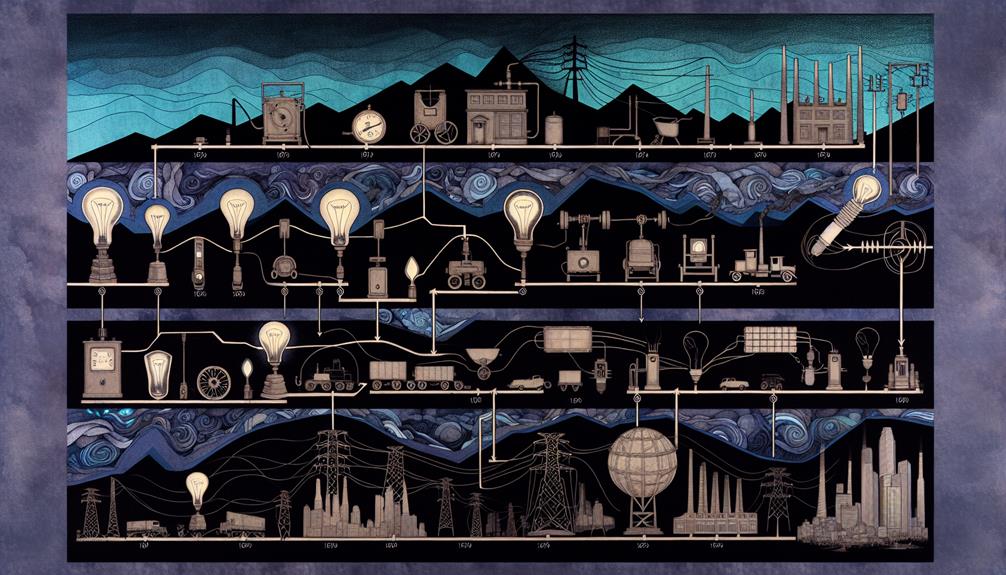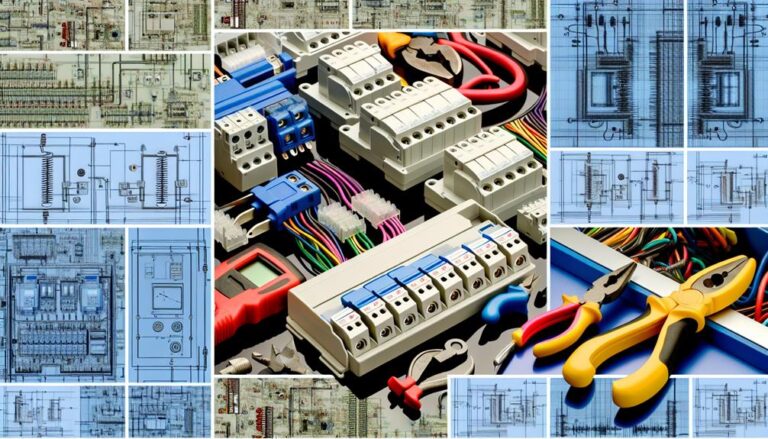Historical Evolution of Electrical Services in Phoenix
Have you ever wondered how electricity came to power the homes and businesses of Phoenix? The historical evolution of electrical services in this vibrant city is a fascinating journey that spans decades of innovation and progress.
From the early days of gas lamps to the modernization of the grid, Phoenix has witnessed significant changes in its electrical infrastructure. But how did it all begin?
Join us as we explore the captivating story of how electricity became an indispensable part of Phoenix’s growth and development. Get ready to uncover the secrets behind the establishment of power companies and the transformation of Phoenix’s electrical services into what they are today.
Key Takeaways
- Early development of electrical infrastructure in Phoenix was marked by the installation of the first power plant and the expansion of electricity distribution to homes and businesses.
- Grid modernization efforts in Phoenix have focused on upgrading infrastructure to meet growing energy demands, incorporating advanced technologies in power distribution systems, and implementing smart grids for real-time monitoring and control.
- The city has embraced renewable energy sources, such as solar power, to reduce reliance on fossil fuels for electricity generation and contribute to environmental conservation and carbon emissions reduction.
- The introduction of advanced metering infrastructure has empowered customers to make informed decisions, optimize efficiency, promote energy conservation, and take control of their electricity usage.
Gas Lamps and the Early Days
During the early days of Phoenix, gas lamps were utilized to provide illumination for the growing city. These gas lamps were an essential part of the city’s infrastructure, ensuring that the streets were well-lit and safe for its residents.
The gas lighting system consisted of a network of gas lines that supplied gas to the lamps, which were then ignited to produce a steady flame. The gas used in these lamps was typically derived from coal or oil, and it was transported through pipes to various locations throughout the city. The lamps themselves were made of glass and metal, designed to withstand the heat and pressure of the burning gas. They were strategically placed along the streets, providing a consistent source of light for pedestrians and drivers alike.
The introduction of gas lamps revolutionized the way cities were illuminated, replacing the outdated methods of using oil lamps or candles. The gas lamps weren’t only brighter but also more efficient, providing a longer-lasting source of light. This advancement in lighting technology allowed the city to expand its boundaries, as it no longer relied solely on natural light or the limited reach of traditional light sources. The gas lamps played a crucial role in the development of Phoenix, providing an essential service that improved the quality of life for its residents.
As the city grew, so did the demand for gas lamps. The gas lines were expanded, and more lamps were installed to meet the increasing needs of the population. The gas lighting system became a symbol of progress and modernity, showcasing the city’s commitment to providing its residents with the best possible amenities. The gas lamps not only illuminated the streets but also illuminated the path towards a brighter future for Phoenix.
Introduction of Electricity
The introduction of electricity in Phoenix marked a significant milestone in the city’s technological advancements, transforming the way residents lit their homes and businesses.
Here are four key aspects of the introduction of electricity in Phoenix:
- Development of Power Plants: To meet the growing demand for electricity, power plants were built to generate and distribute electrical power throughout the city. These plants utilized fossil fuels such as coal and natural gas to produce electricity, which was then transmitted through a network of power lines.
- Expansion of Electrical Infrastructure: The introduction of electricity necessitated the development of an extensive electrical infrastructure. This involved the installation of power lines, transformers, and substations to ensure a reliable and efficient supply of electricity to homes and businesses.
- Adoption of Electrical Appliances: With the availability of electricity, residents embraced electrical appliances that made their lives easier and more convenient. Electric lights replaced gas lamps, electric stoves replaced wood-burning stoves, and electric fans provided relief from the sweltering Arizona heat.
- Economic Growth and Industrialization: The introduction of electricity fueled economic growth and industrialization in Phoenix. Industries now had access to a reliable source of power, enabling them to expand their operations and increase productivity. This led to job creation and attracted new businesses to the city.
The introduction of electricity in Phoenix revolutionized the way people lived and worked, paving the way for further technological advancements and progress in the years to come.
Establishment of Power Companies
Power companies played a crucial role in the establishment and expansion of electrical services in Phoenix, facilitating the distribution of electricity to homes and businesses across the city. The establishment of power companies in Phoenix can be traced back to the late 19th century, a time when the demand for electricity was rapidly increasing. As the population grew and industries flourished, the need for a reliable and efficient source of power became paramount. Power companies emerged to fill this void, investing in the construction of power plants and the development of transmission and distribution systems.
One of the earliest power companies in Phoenix was the Arizona Power Company, founded in 1885. This company played a significant role in electrifying the city, installing power lines and providing electricity to residential and commercial customers. Over the years, other power companies like the Salt River Valley Water Users’ Association and the Phoenix Light and Fuel Company emerged, further expanding the electrical services in the city.
These power companies not only provided electricity but also played a pivotal role in the development of infrastructure to support the growing demand. They built power plants, established substations, and laid down an extensive network of transmission and distribution lines. This infrastructure allowed electricity to be transported efficiently, ensuring a reliable supply to the consumers.
Furthermore, the establishment of power companies led to the creation of jobs and economic growth in Phoenix. The construction and operation of power plants and distribution networks required a skilled workforce, stimulating employment opportunities in the city. Additionally, the availability of electricity attracted businesses and industries, contributing to the overall prosperity of the region.
Modernization of the Grid
As power companies in Phoenix facilitated the distribution of electricity and supported the city’s growth, the modernization of the grid became essential for meeting the increasing demands of a rapidly developing city.
Here are four key aspects of the modernization of the grid in Phoenix:
- Advanced Metering Infrastructure (AMI): The implementation of AMI has allowed for more accurate and real-time measurement of electricity consumption. This technology enables customers to have better control over their energy usage and provides power companies with more accurate data for billing and load management.
- Smart Grid Technologies: The integration of smart grid technologies has improved the efficiency and reliability of the electrical grid. These technologies include sensors, automation, and communication systems that enable real-time monitoring and control of the grid. This allows for quicker detection and response to power outages and better management of electricity distribution.
- Grid Resiliency: The modernization efforts in Phoenix have focused on enhancing the resiliency of the electrical grid. This involves implementing measures to mitigate the impact of extreme weather events, such as storms and heatwaves, on the grid. It also includes the adoption of renewable energy sources and energy storage systems, which contribute to a more sustainable and resilient grid.
- Demand Response Programs: To balance the increasing demand for electricity, power companies in Phoenix have implemented demand response programs. These programs incentivize customers to reduce their electricity usage during periods of high demand, thus alleviating strain on the grid. This helps to maintain grid stability and reliability while promoting energy conservation.
The modernization of the grid in Phoenix has been crucial in meeting the growing energy demands of the city. By incorporating advanced technologies, enhancing grid resiliency, and implementing demand response programs, power companies have ensured a reliable and sustainable supply of electricity for the residents of Phoenix.
Phoenix’s Electrical Services Today
What are the current advancements and innovations in electrical services that make Phoenix a model city for efficient power distribution and reliable electricity supply?
Today, Phoenix boasts a cutting-edge electrical infrastructure that sets the standard for other cities. One key advancement is the implementation of smart grids, which have revolutionized power distribution. These grids utilize advanced sensors, communication networks, and data analytics to monitor and control the flow of electricity in real time. This enables utilities to detect and respond to outages more quickly, minimizing disruptions and ensuring a reliable supply of electricity.
Additionally, Phoenix has embraced renewable energy sources, such as solar power, to reduce its reliance on fossil fuels. The city has invested in solar farms, rooftop solar panels, and battery storage systems to harness the abundant sunlight and provide clean, sustainable energy to its residents.
Furthermore, Phoenix has implemented advanced metering infrastructure, allowing customers to monitor their energy usage in real time and make informed decisions to optimize efficiency. This promotes energy conservation and empowers individuals to take control of their electricity consumption.
With these advancements and innovations, Phoenix stands as a shining example of a city that prioritizes efficient power distribution, reliable electricity supply, and sustainable energy practices.







